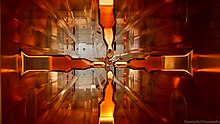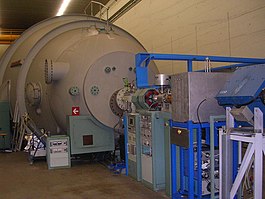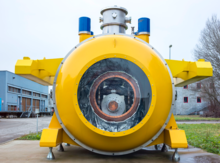435:
202:
412:
332:
250:
458:) spectrometer is installed at the Tandem-Alpi-Piave complex. It is currently coupled to the PRISMA magnetic spectrometer. In the future, thanks to the new beam interconnection between the Tandem-Alpi-Piave complex and the SPES project, the AGATA system will receive exotic beams produced by the SPES facility.
236:
has been under construction since 2007, and the alpha phase of the project, featuring a new cyclotron, was inaugurated in
December 2016. Subsequent beta, gamma, and delta phases are planned, approved, and funded by INFN and the Italian government; it will be possible to synthesize new isotopes and
213:
In subsequent years, several accelerators were newly installed or upgraded. The original CN accelerator, whose operations commenced with the opening of the laboratory, was upgraded to allow use and study of heavier ions. More advanced facilities were installed in the next decades: the XTU Tandem
214:
accelerator in 1981 (inaugurated in 1982) and the Linear
Superconducting Accelerator (ALPI) in 1991. The installation of new facilities enabled more advanced studies to be performed at the Legnaro laboratories, increasing its importance in international research in nuclear physics.
403:. A variety of medically useful radioisotopes will also be mass produced as part of the project's gamma phase. By 2017, significant progress was made on the construction of the SPES facility; the first beams of exotic isotopes are expected to be available in late 2019.
169:, where five accelerators are currently used. It is one of the most important facilities in Italy for research in these fields. The main future project of the laboratory is the Selective Production of Exotic Species (SPES), in which various
442:
The major apparatus installed in the laboratories includes PRISMA (heavy ion magnetic spectrometer, with trajectory reconstruction system), GALILEO (Hyper pure
Germanium gamma-ray detector system, that can be complemented by
229:; the last was internationally recognized in the 1990s. The recent focus of the Legnaro Laboratories, and the main future project, is SPES (Selective Production of Exotic Species). A new accelerator for the production of
197:
and research commenced within the next year. After initial investigations demonstrated the conceived role of the
Legnaro Laboratories in nuclear physics research, the facility became integrated into the INFN in 1968.
826:
Stefanini, A. M.; Corradi, L.; Maron, G.; Pisent, A.; Trotta, M.; Vinodkumar, A. M.; Beghini, S.; Montagnoli, G.; Scarlassara, F.; Segato, G. F.; De Rosa, A. (2002-04-22).
415:
GALILEO HPGe system for gamma-ray spectroscopy, installed in the 2nd experimental hall of the Tandem - Alpi - Piave accelerator complex at
Legnaro National Laboratories.
193:
decided that a new laboratory would be built near
Legnaro, rather than install new equipment in older facilities. The laboratory was founded in 1960 by physicist
438:
PRISMA magnetic spectrometer at experimental hall n.1, Tandem-ALPI-PIAVE accelerator complex. On the right, the first elements for the AGATA system installation.
622:
423:
are underway at several
European laboratories including the Legnaro National Laboratories. They address the structure of atomic nuclei, as well as their
431:
processes. At present, LNL delivers stable ion beams, but with the development of SPES high-intensity radioactive ion beams will also be available.
600:
505:
974:
964:
158:
127:
379:) project involves the construction of several new accelerators specially designed for the production of radioisotopes. In the beta phase,
82:
467:
303:): Started operation in 1991. A superconducting cryogenic linear accelerator. Boosts beams from the TANDEM-XTU and PIAVE accelerators.
351:
research. It became operational in 2004, and has been continuously in operation since then. In 2016, it was proven that the AURIGA
647:
Branca, A.; Bonaldi, M.; Cerdonio, M.; et al. (2017). "Search for light scalar Dark Matter candidate with AURIGA detector".
472:
969:
352:
959:
391:
and produce beams with these isotopes at higher intensities than those currently available. These include nuclei near the
424:
434:
313:): Entered operation in late 2014. Superconducting linear accelerator used as injector to ALPI. A few meters in length.
344:
451:
206:
201:
564:
781:
Broggini, C.; Straniero, O.; Taiuti, M. G. F.; et al. (2019). "Experimental nuclear astrophysics in Italy".
626:
589:. 8th International Topical Meeting on Nuclear Applications and Utilization of Accelerators. Pocatello, Idaho.
501:
444:
420:
273:, but nowadays run in 5.57 MeV energy. 7 meter tall (vertically installed) electrostatic accelerator.
226:
912:
Nuclear
Instruments and Methods in Physics Research Section B: Beam Interactions with Materials and Atoms
185:
was first suggested in 1956 to promote nuclear physics research in Italy in addition to previous work in
533:
907:
827:
719:
166:
40:
396:
348:
190:
55:
48:
908:"γ-ray tracking with AGATA: A new perspective for spectroscopy at radioactive ion beam facilities"
935:
808:
790:
682:
656:
750:"The SPES radioactive ion beam facility at the Legnaro National Laboratories and the EDM search"
927:
888:
847:
674:
411:
392:
218:
72:
919:
878:
839:
800:
761:
727:
666:
540:
331:
238:
222:
194:
186:
704:
363:. The experiment is closed and the AURIGA antenna is an exhibit at LNL (since April 2021).
766:
749:
428:
380:
162:
44:
36:
883:
866:
723:
843:
953:
939:
812:
584:
170:
686:
289:): inaugurated 1982. Beam energies up to few hundred MeV. Electrostatic accelerator.
670:
323:
All accelerators are used to accelerate various ions for nuclear physics purposes.
249:
804:
731:
356:
230:
923:
601:"From stars to medicine: INFN Legnaro Laboratories inaugurate the SPES project"
262:
There are six accelerators in operation at the
Legnaro National Laboratories:
217:
Currently, most work at the
Legnaro National Laboratories involves studies of
931:
892:
851:
161:(INFN). The primary focus of research at this laboratory is in the fields of
97:
84:
400:
678:
867:"Perspectives for the gamma-ray spectroscopy at LNL: the GALILEO project"
534:
The Legnaro Laboratory: 50 Years (1961-2011) - The Origin and the History
233:
388:
384:
359:
searches, and perhaps more suitable than more modern detectors such as
182:
137:
68:
544:
340:
447:) and EXOTIC (a device for light exotic beam production and study).
795:
661:
433:
410:
330:
248:
200:
76:
269:: installed in 1961. Maximum energy reached for beams was 7
360:
705:"The SPES project at the INFN-Laboratori Nazionali di Legnaro"
270:
834:. 5th International Conference on Radioactive Nuclear Beams.
586:
The accelerator driven SPES-BNCT project at INFN Legnaro Labs
583:
Esposito, J.; Colautti, P.; Pisent, A.; et al. (2007).
335:
Auriga antenna exposed inside Legnaro National laboratories.
279:: installed in 1971, 2 MeV beams. Electrostatic accelerator.
253:
The XTU Tandem accelerator at Legnaro National Laboratories
157:) is one of the four major research centers of the Italian
455:
319:: inaugurated 2 December 2016. Part of the SPES project.
572:. NEA Workshop. Istituto Nazionale di Fisica Nucleare.
173:
will be produced for research and medicinal purposes.
311:
Positive Ion Accelerator for Very Low velocity ions
133:
121:
113:
64:
54:
32:
24:
623:"AURIGA EXPERIMENT, RESPONSIBLE: Massimo Cerdonio"
339:The Legnaro National Laboratories are the site of
399:that play an important role in the astrophysical
383:at 10 fissions per second and fragmentation of
387:will be studied to yield exotic neutron-rich
8:
828:"The heavy-ion magnetic spectrometer PRISMA"
502:"INFN-LNL - Laboratori Nazionali di Legnaro"
19:
743:
741:
18:
882:
794:
765:
660:
504:. Italian Institute of Nuclear Physics.
698:
696:
527:
525:
523:
484:
355:detector is sufficiently sensitive for
508:from the original on 14 September 2018
377:Selective Production of Exotic Species
159:National Institute for Nuclear Physics
871:Journal of Physics: Conference Series
754:Journal of Physics: Conference Series
558:
556:
554:
496:
494:
492:
490:
488:
181:The establishment of a laboratory in
7:
450:Since 2021, the travelling European
209:) at Legnaro National Laboratories.
468:Laboratori Nazionali del Gran Sasso
301:Linear Superconducting Accelerator
14:
603:. Research Italy. 1 December 2016
473:Laboratori Nazionali di Frascati
767:10.1088/1742-6596/1056/1/012014
147:Laboratori Nazionali di Legnaro
20:Laboratori Nazionali di Legnaro
884:10.1088/1742-6596/366/1/012044
671:10.1103/PhysRevLett.118.021302
205:Resonant accelerating cavity (
1:
844:10.1016/S0375-9474(01)01578-0
566:Legnaro National Laboratories
456:Advanced Gamma Tracking Array
297:Acceleratore Lineare Per Ioni
151:Legnaro National Laboratories
975:1960 establishments in Italy
965:Research institutes in Italy
783:La Rivista del Nuovo Cimento
345:gravitational wave detector
991:
924:10.1016/j.nimb.2019.05.041
865:Ur, Calin A (2012-05-28).
563:Bettoni, D. (2 May 2017).
906:Reiter, P. (2020-01-15).
805:10.1393/ncr/i2019-10157-1
732:10.1393/ncc/i2015-15181-3
241:once they are completed.
239:medically useful isotopes
760:(1): 012014–1–012014–6.
655:(2): 021302–1–021302–5.
748:de Angelis, G. (2018).
649:Physical Review Letters
245:Facilities and projects
625:. INFN. Archived from
445:scintillator detectors
439:
421:gamma-ray spectroscopy
416:
407:Gamma-ray spectroscopy
336:
254:
227:gamma-ray spectroscopy
210:
98:45.353278°N 11.95056°E
970:Laboratories in Italy
532:Ricci, R. A. (2013).
437:
414:
334:
252:
204:
960:Physics laboratories
167:nuclear astrophysics
41:nuclear astrophysics
724:2016NCimC..38..181P
349:gravitational waves
191:University of Padua
103:45.353278; 11.95056
94: /
49:accelerator physics
21:
718:(6): 181–1–181–5.
703:Prete, G. (2016).
440:
419:Experiments using
417:
393:nuclear drip lines
347:for astrophysical
337:
255:
211:
33:Research type
832:Nuclear Physics A
545:10.1063/1.4812899
223:nuclear reactions
219:nuclear structure
143:
142:
982:
944:
943:
903:
897:
896:
886:
862:
856:
855:
823:
817:
816:
798:
778:
772:
771:
769:
745:
736:
735:
712:Il Nuovo Cimento
709:
700:
691:
690:
664:
644:
638:
637:
635:
634:
619:
613:
612:
610:
608:
597:
591:
590:
580:
574:
573:
571:
560:
549:
548:
539:(Report). INFN.
538:
529:
518:
517:
515:
513:
498:
195:Antonio Rostagni
187:particle physics
123:Operating agency
109:
108:
106:
105:
104:
99:
95:
92:
91:
90:
87:
22:
990:
989:
985:
984:
983:
981:
980:
979:
950:
949:
948:
947:
905:
904:
900:
864:
863:
859:
825:
824:
820:
780:
779:
775:
747:
746:
739:
707:
702:
701:
694:
646:
645:
641:
632:
630:
621:
620:
616:
606:
604:
599:
598:
594:
582:
581:
577:
569:
562:
561:
552:
536:
531:
530:
521:
511:
509:
500:
499:
486:
481:
464:
429:nucleosynthesis
409:
369:
329:
260:
247:
189:. In 1959, the
179:
163:nuclear physics
138:www.lnl.infn.it
124:
102:
100:
96:
93:
88:
85:
83:
81:
80:
79:
45:applied physics
37:Nuclear physics
17:
16:Research center
12:
11:
5:
988:
986:
978:
977:
972:
967:
962:
952:
951:
946:
945:
898:
857:
838:(1): 217–221.
818:
773:
737:
692:
639:
614:
592:
575:
550:
519:
483:
482:
480:
477:
476:
475:
470:
463:
460:
425:unbound states
408:
405:
397:shell closures
368:
365:
328:
325:
321:
320:
314:
304:
290:
280:
274:
259:
256:
246:
243:
178:
175:
141:
140:
135:
131:
130:
125:
122:
119:
118:
115:
111:
110:
66:
62:
61:
58:
52:
51:
34:
30:
29:
26:
15:
13:
10:
9:
6:
4:
3:
2:
987:
976:
973:
971:
968:
966:
963:
961:
958:
957:
955:
941:
937:
933:
929:
925:
921:
917:
913:
909:
902:
899:
894:
890:
885:
880:
876:
872:
868:
861:
858:
853:
849:
845:
841:
837:
833:
829:
822:
819:
814:
810:
806:
802:
797:
792:
788:
784:
777:
774:
768:
763:
759:
755:
751:
744:
742:
738:
733:
729:
725:
721:
717:
713:
706:
699:
697:
693:
688:
684:
680:
676:
672:
668:
663:
658:
654:
650:
643:
640:
629:on 2006-05-10
628:
624:
618:
615:
602:
596:
593:
588:
587:
579:
576:
568:
567:
559:
557:
555:
551:
546:
542:
535:
528:
526:
524:
520:
507:
503:
497:
495:
493:
491:
489:
485:
478:
474:
471:
469:
466:
465:
461:
459:
457:
453:
448:
446:
436:
432:
430:
427:and roles in
426:
422:
413:
406:
404:
402:
398:
394:
390:
386:
382:
378:
374:
366:
364:
362:
358:
354:
353:resonant mass
350:
346:
342:
333:
326:
324:
318:
317:P70 cyclotron
315:
312:
308:
305:
302:
298:
294:
291:
288:
284:
281:
278:
275:
272:
268:
265:
264:
263:
257:
251:
244:
242:
240:
237:mass produce
235:
232:
228:
224:
220:
215:
208:
203:
199:
196:
192:
188:
184:
176:
174:
172:
171:radionuclides
168:
164:
160:
156:
152:
148:
139:
136:
132:
129:
126:
120:
116:
112:
107:
78:
74:
70:
67:
63:
60:Faiçal Azaïez
59:
57:
53:
50:
46:
42:
38:
35:
31:
27:
23:
915:
911:
901:
874:
870:
860:
835:
831:
821:
786:
782:
776:
757:
753:
715:
711:
652:
648:
642:
631:. Retrieved
627:the original
617:
605:. Retrieved
595:
585:
578:
565:
510:. Retrieved
449:
441:
418:
376:
372:
370:
338:
322:
316:
310:
306:
300:
296:
292:
286:
282:
276:
266:
261:
258:Accelerators
216:
212:
180:
154:
150:
146:
144:
86:45°21′11.8″N
918:: 221–226.
357:dark matter
231:radioactive
101: /
25:Established
954:Categories
877:: 012044.
796:1902.05262
662:1607.07327
633:2012-12-18
607:26 January
512:13 January
479:References
287:TANDEM-XTU
283:XTU-TANDEM
940:182443952
932:0168-583X
893:1742-6596
852:0375-9474
813:104292057
401:r-process
234:ion beams
89:11°57′2″E
687:23863620
679:28128622
506:Archived
462:See also
389:isotopes
114:Nickname
65:Location
56:Director
720:Bibcode
385:uranium
381:fission
277:AN 2000
183:Legnaro
177:History
134:Website
69:Legnaro
938:
930:
891:
850:
811:
685:
677:
341:AURIGA
327:AURIGA
225:, and
936:S2CID
809:S2CID
791:arXiv
789:(3).
708:(PDF)
683:S2CID
657:arXiv
570:(PDF)
537:(PDF)
452:AGATA
307:PIAVE
77:Italy
73:Padua
928:ISSN
889:ISSN
848:ISSN
758:1056
675:PMID
609:2019
514:2019
395:and
373:SPES
371:The
367:SPES
361:LIGO
343:, a
293:ALPI
285:(or
165:and
145:The
128:INFN
28:1960
920:doi
916:463
879:doi
875:366
840:doi
836:701
801:doi
762:doi
728:doi
667:doi
653:118
541:doi
271:MeV
207:RFQ
155:LNL
117:LNL
956::
934:.
926:.
914:.
910:.
887:.
873:.
869:.
846:.
830:.
807:.
799:.
787:42
785:.
756:.
752:.
740:^
726:.
716:38
714:.
710:.
695:^
681:.
673:.
665:.
651:.
553:^
522:^
487:^
299:,
267:CN
221:,
153:,
75:,
71:,
47:,
43:,
39:,
942:.
922::
895:.
881::
854:.
842::
815:.
803::
793::
770:.
764::
734:.
730::
722::
689:.
669::
659::
636:.
611:.
547:.
543::
516:.
454:(
375:(
309:(
295:(
149:(
Text is available under the Creative Commons Attribution-ShareAlike License. Additional terms may apply.


